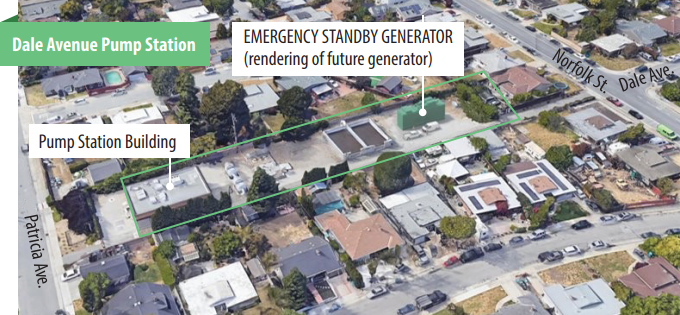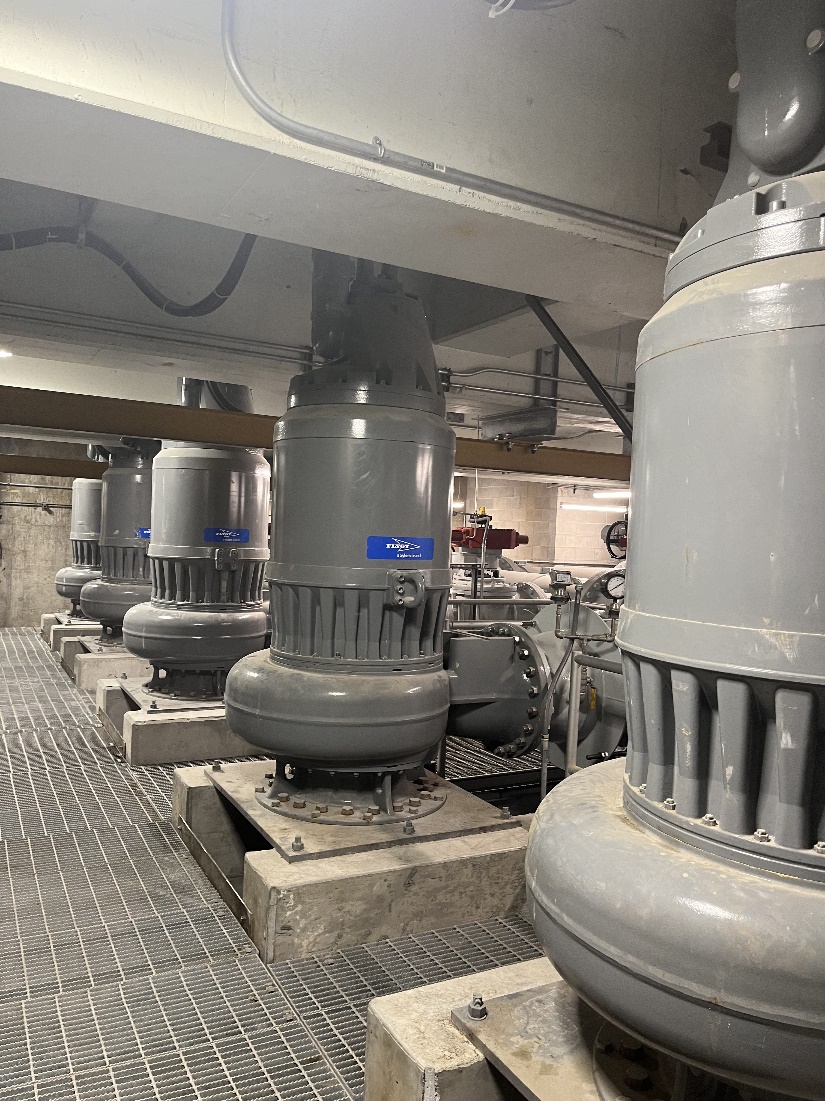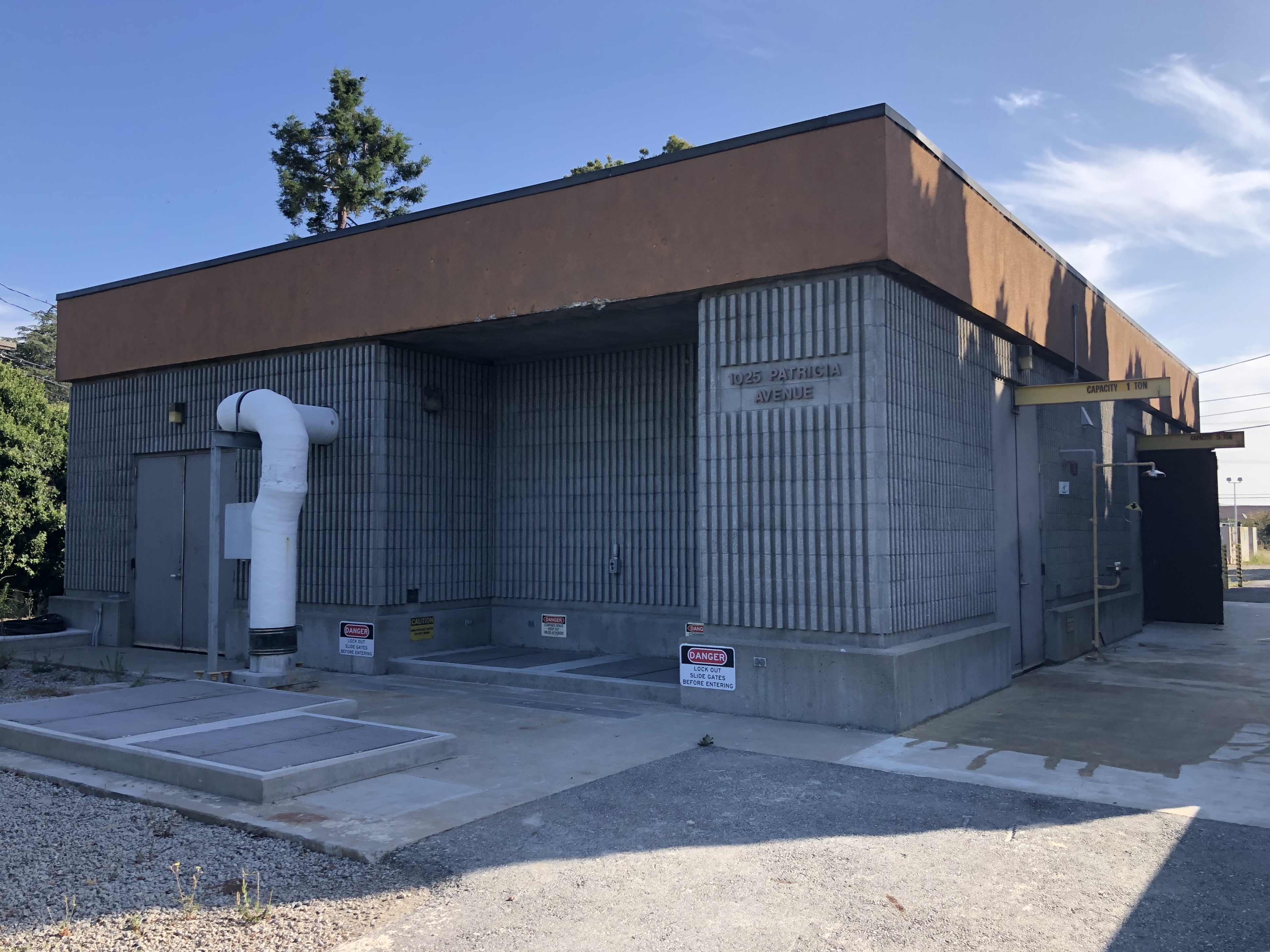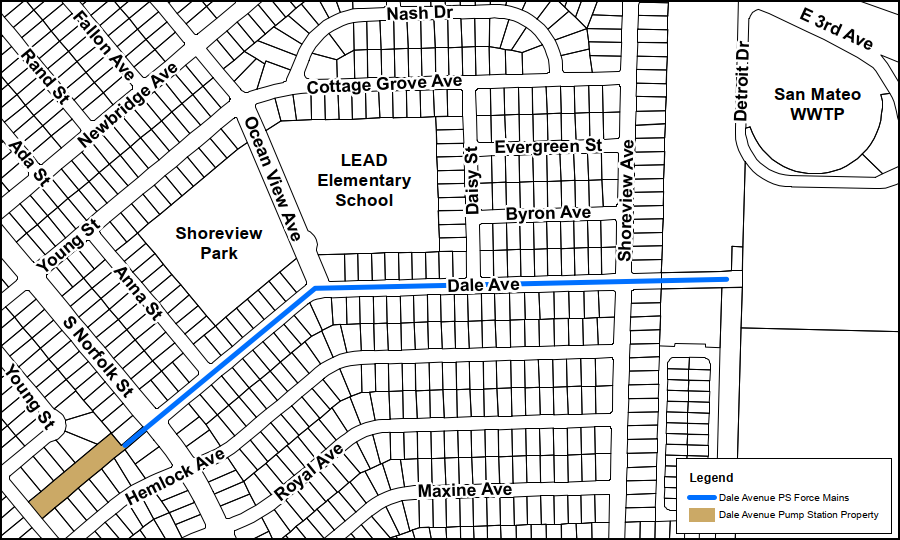Project Status
The City has completed constructing sewer infrastructure improvements at the pump station, and will now need to install an emergency standby generator. The pump station is vital for the operation of the City’s sewer system and must remain operational 24/7. The purpose of the new emergency standby generator is to provide a power supply to the pump station in the event of a power outage. The existing generator requires replacement to be compliant with air quality requirements. It will be installed east of the pump station building, as shown in the image to the right.
The proposed site plan and equipment elevations can be seen here
The City has been working on the design to replace the existing emergency standby generator with a new emergency standby generator at the Dale Avenue Pump Staton since 2023. The upcoming emergency standby generator installation involves site preparation, excavation, cable trenching, foundation piles, concrete pours, generator placement and wiring.
During the installation of the generator, residents can expect to experience some short-term inconveniences, such as noise and vibration due to trucks and equipment operating around and at the site. Mitigation measures will remain in place to minimize the effects of the project on residents. Notifications will be distributed to potentially affected neighbors prior to work beginning.
The overall duration of the generator replacement work is anticipated to be six months. Contractors are scheduled to perform cable trenching and ducting work starting March 2024 followed by piling work and construction of a concrete foundation. The work will be performed using a vacuum excavator, a drilling machine for piling, concrete machinery, trucks for haulage and disposal. Subsequently installation of the generator using a crane and wiring work will take place. All work will be performed within the DAPS parcel. Work will take place between the hours of 8:00 AM and 5:00 PM, Monday through Friday. Additional potential temporary impacts may include:
- Parking restrictions on Norfolk Street and Patricia Ave to allow temporary parking and access of construction equipment
- One lane traffic controlled by flaggers when required
- Noise impacts due to construction equipment
- Minor vibration during piling work and construction activities

Construction Notices
The construction notices below highlight recent construction updates related to the DAPS project.
Project Description
Heavy rains overwhelm the San Mateo wastewater collection system. The extra rainwater causes sewer overflows at some manholes and at the wastewater treatment plant. These sewer overflows pose a danger to human health and the environment by contaminating our streets, creeks, lagoons, and beaches, and the San Francisco Bay.
The Dale Avenue Pump Station Upgrade will alleviate this problem by improving the wastewater collection system’s ability to manage heavy rainfall, reducing overflows, and helping the City meet important regulatory requirements. By increasing Dale Avenue Pump Station’s amount of wastewater the pump station can handle, we can reduce the risk of sewer overflows, which is better for all of us and our environment.
The Dale Avenue Pump Station Upgrade will improve the wastewater collection system’s ability to manage heavy rainfall, reducing overflows, and helping the City meet important regulatory requirements. By increasing the amount of wastewater the Dale Avenue Pump Station can handle, we can reduce the risk of sewer overflows, which is better for all of us and our environment.
Pump stations are a critical component of the wastewater treatment process. They help move wastewater from homes, businesses, and other facilities to the wastewater treatment plant (WWTP) by “lifting” wastewater from lower elevations to higher elevations so gravity can take over, sending the City’s wastewater to the treatment plant.
Upgrading work at the Dale Avenue Pump Station that has been completed to date include:
- Replacing pumps, piping, valves, and other associated elements in the well
- Lining the existing force mains that convey wastewater from the pump station to the wastewater treatment plant
- Process improvements to the well
- Improving the electrical and instrumentation systems and heating, ventilation, and air conditioning system
- Making some safety and accessibility improvements
- Replacing a portion of the pipe in the pump station yard
Prior Upgrade Work
Construction began in 2020 and will continue until Fall 2024. Work along Dale Avenue will repair the existing force mains that carry wastewater from the Dale Avenue Pump Station to the City’s treatment plant. Two pipelines run the length of Dale Avenue between both facilities that needed to be repaired. Instead of excavating trenches along Dale Ave to repair the full length of the pipeline, the City chose a less impactful method to repair the pipes: plastic liner material will be inserted into the pipe and filled with water to push it along the pipeline. Water expands the liner to take the shape of the inside of the existing pipe; then the water is heated and the resins in the liner harden into place. The rehabilitation of the first pipeline was completed in 2020; the second pipeline was rehabilitated in 2021.
For 2021 work, the City adjusted the rehabilitation method to reduce community inconveniences experienced in 2020. The lining system used in 2020 required the hot water to be heated and circulated non-stop until the resin materials hardened. The duration of the heating lasts as long as needed to reach a specific temperature to make the resin cure; boilers were required to operate overnight. The City used a material that does not require constant heating to reach the curing point. The contractor installed the liner and operated the boilers during the day and shut them down at the end of the workday. Switching the pipe lining material allowed for longer distances between lining pits, which allowed the number of access pits on Dale Ave to be reduced.
In 2020, the Dale Avenue roadway had three access pit locations and two additional pits off the roadway (at the two ends of the force main rehabilitation limits). The 2021 work removed one of the access lining pit locations in the Dale Avenue roadway (See the map). At each pit location, the contractor dewatered groundwater from the excavation to install fittings and gain access to line the pipe. The generators used to power the dewatering pumps were located near the pit locations and enclosed in sound reducing blankets, similar to the method used in 2020. These pumps operated while the access pits were open.
In 2020, the contractor saw cut the underground layer of concrete before removal to reduce vibrations and noise.
On September 20, 2022 at 6 p.m. the City held a virtual neighborhood meeting to discuss the details of the work associated with the emergency standby generator for the Dale Avenue Pump Station project. The virtual meeting provided details of the work related to the emergency standby generator and included construction schedules and what the community can expect. You can view a recording of the meeting here, or view the presentation by clicking here.
What Does this Mean for You?
The City and those working on the upgrade are committed to reducing impacts and inconveniences, such as noise, dust, and extra traffic, to our community while completing this project. All work will be self-contained at the pump station.

Contractor Name:
Anvil Builders
Contact:
Bryan Burnham, Project Manager of Anvil Builders at 209.346.2980 or bburnham@anvilbuilders.com





